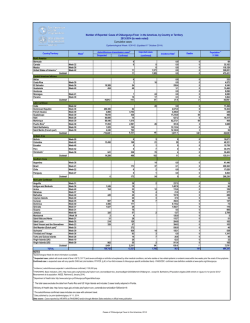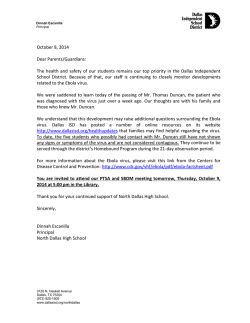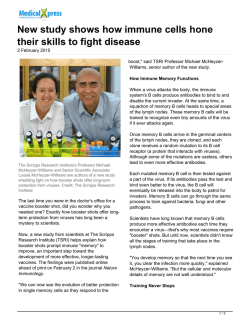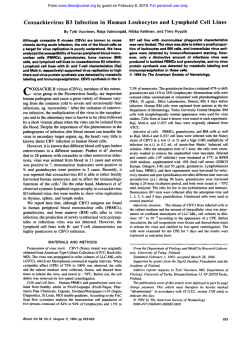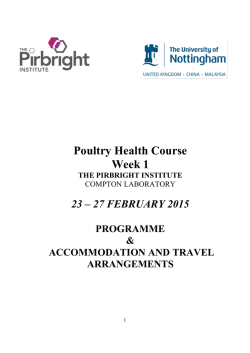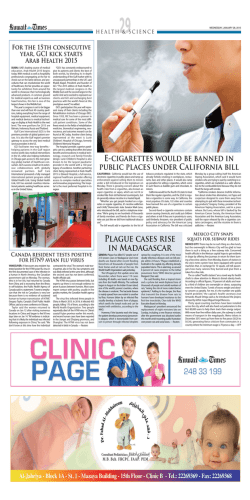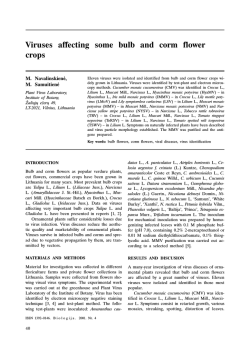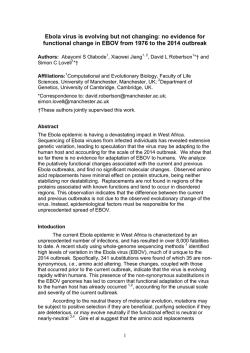
Rapid Risk Assessment on chikungunya case in - ECDC
RAPID RISK ASSESSMENT Chikungunya case in Spain without travel history to endemic areas* 21 August 2015 Main conclusions and options for response • This is the first chikungunya case reported from Spain without travel history to endemic areas. The infection occurred most likely in the city of Gandía, Valencia community. The case developed symptoms on 7 July while travelling in France. It is very unlikely that the infection occurred in France because of the short duration of the case’s stay in the Hérault district and the fact that no imported chikungunya cases were reported in this district in France in 2015. • Europe is vulnerable to the autochthonous transmission of chikungunya virus. The risk for onward transmission in Europe is linked to importation of virus by viraemic patients in areas with competent vectors (Aedes albopictus in mainland Europe, primarily around the Mediterranean, and Aedes aegypti on Madeira). Autochthonous transmission from an imported viraemic chikungunya case during the summer season in the EU is possible. • Exposure to infected mosquitoes is the principal risk for infection in currently affected areas. Prevention of chikungunya is essentially based on vector control and personal protection against mosquito bites. • Travellers returning from outbreak areas should seek medical care if presenting with symptoms consistent with chikungunya. Such measures reduce the risk of viral introduction to the European mosquito population and also limit the establishment of a local cycle of transmission during the summer season. • Preparedness regarding chikungunya in the EU requires the capacity to detect possible cases in areas with presence of the competent vectors; strengthened surveillance systems, including laboratory capacity for the confirmation and rapid notification of cases (based on a standardised case definition); the review of contingency plans for mosquito-borne outbreaks; education and collaboration of the general public on how to control mosquito breeding sites; strengthened vector surveillance systems; and rapid implementation of vector control measures around each case. • EU blood safety authorities need to be vigilant regarding the epidemiological situation in outbreak areas. Suggested citation: European Centre for Disease Prevention and Control. Chikungunya case in Spain without travel history to endemic areas – 21 August 2015, Stockholm, 2015. * Erratum - 16 September 2015: The chikungunya case discussed in this rapid risk assessment has been discarded, based on the results of additional laboratory investigation. Despite the fact that autochtonous transmission has not been confirmed, the conclusions of ECDC’s rapid risk assessment remain valid. © European Centre for Disease Prevention and Control, Stockholm, 2015 RAPID RISK ASSESSMENT Chikungunya case in Spain without travel history to endemic areas – 21 August 2015 Source and date of request Directorate-General for Health and Food Safety (DG SANTE), Unit C3: Health threats, 14 August 2015 Public health issue The assessment of the first chikungunya case reported from Spain without travel history to endemic areas, and the assessment of the risk of possible onwards transmission. Consulted experts External experts: Fernando Simón Soria, Carmen Amela Heras (Ministry of Health, Social Services and Equity; Spain); Henriette De Valk, Harold Noel (Institut de Veille Sanitaire, France). The experts have submitted their declaration of interest and the review of these declarations revealed no conflicts of interest. ECDC experts: Alastair Donachie, Josep Jansa, Eva Warms-Petit, Wim Van Bortel, Hervé Zeller Disease background information Chikungunya is a mosquito-borne viral disease caused by a single-strand, positive-sense RNA alphavirus from the Togaviridae family. It is transmitted by the bite of infected Aedes mosquitoes, primarily Aedes aegypti and Aedes albopictus, two species which are active during the day. The incubation period ranges from 2 to 10 days, with an average of 3 days [1,2]. The typical clinical signs of the disease are high fever, myalgia, skin rash and arthralgia. The latter may persist for weeks or months, causing a significant disease burden in the affected community [3-6]. General complications include myocarditis, hepatitis, ocular and neurological disorders [7]. Neither specific treatment nor licensed vaccines are currently available [8,9]. The medical management costs and productivity losses for large chikungunya virus outbreaks are associated with an important economic burden [10]. Generally, the majority of infections are symptomatic (> 75%) [11]. In humans, the viral load in the blood can be very high at the beginning of the infection and lasts 5–6 days after onset of fever [12]. Transmission of chikungunya virus infection through transfusion and transplantation has not been reported in humans although animal models showed the ability of such transmission. Transmission through blood transfusion has recently been described in Australia for Ross River disease, which is caused by an infection with an alphavirus closely related to the chikungunya virus [13]. Chikungunya virus infection was detected in 0.54% (three out of 557) of the asymptomatic donors investigated in Puerto Rico in April–August 2014, with estimated viral loads ranging from 2.9 x 105 to 9.1 x 107 copies/ml. Two of the three donors remained asymptomatic after donation [14]. The possibility of donor-derived chikungunya virus transmission requires that preventive safety measures are applied to donors residing in, or returning from, affected areas. The appropriate deferral period for clinical chikungunya is unknown but would likely be in the order of several weeks after the resolution of symptoms. Chikungunya virus can be identified using RT-PCR or viral isolation during the first week of illness. Serological diagnosis can be performed by detection of specific IgM antibodies in serum specimen from day 4–5 after the onset of symptoms, preferably confirmed by neutralisation. Confirmatory diagnosis can also be done by detection of a four-fold rise of specific chikungunya antibodies titre in a paired serum sample (acute and convalescent specimens). Differential diagnosis with dengue should be considered because both viruses are circulating in many tropical countries and co-infections are reported [15]. Both viruses are also transmitted by mosquitoes of the same species. Epidemiological situation Chikungunya is endemic in parts of Africa, south-east Asia, the Indian subcontinent and the Americas. Globally, the most recent large outbreaks were reported in 2005–2006 from La Réunion, Mauritius, Mayotte, various Indian states and, from the end of 2013, in the Americas. In December 2013, chikungunya emerged on the island of Saint Martin in French Caribbean and quickly spread to North, Central and South America. This was the first documented autochthonous transmission of chikungunya virus in the Americas. As of 14 August 2015, the WHO Pan American Health Organization (PAHO) has reported 496 807 suspected and confirmed cases of chikungunya virus infection and 64 deaths in the Americas so far this year. The cumulative number of cases has reached 1 640 252 since the start of the epidemic in December 2013 [16]. Since late 2014, outbreaks of chikungunya have been reported in the Pacific islands with confirmed autochthonous cases reported in the following countries and territories: American Samoa, Cook Islands, Micronesia, Fiji, French Polynesia, Kiribati, Marshall Islands, Nauru, New Caledonia, Papua New Guinea, Tonga, Tokelau and Samoa. In French Polynesia, the epidemic of chikungunya was officially declared over on 22 March 2015 [17]. In recent 2 RAPID RISK ASSESSMENT Chikungunya case in Spain without travel history to endemic areas – 21 August 2015 months, there has been a significant reduction of the number of cases reported in Kiribati, American Samoa and Samoa. As of 18 August 2015, the number of chikungunya cases reported in the Marshall Islands is increasing, and decreasing in Cook Islands and American Samoa [18]. Cases were also reported in 2015 from different states in India and from Singapore [19]. Autochthonous cases within continental Europe were reported from Emilia Romagna, Italy (217 cases in 2007) [20]; Var, France (2 cases in 2010) [21]; and Montpellier, Hérault, France (12 cases, including 11 confirmed in 2014) [22]. Every year, imported cases among tourists are identified in several European countries. During 2008–2013, 547 imported chikungunya cases were reported by EU/EEA countries to ECDC (41 cases in 2008, 149 cases in 2009, 179 cases in 2010, 55 cases in 2011, 51 cases in 2012, and 72 cases in 2013). The probable country of infection was known for 327 cases. The most frequently reported probable countries of infection were Asian countries: India (38%), the Maldives (10%), Sri Lanka (9%), Thailand (9%) and Indonesia (8%). In 2014, 1450 cases (including 875 confirmed cases) were imported into the EU as reported by 13 EU countries. Of the 1178 cases for which the probable country of origin is known, 81% were from the Caribbean (mainly the Dominican Republic, Guadeloupe and Martinique), 11% were from North, Central or South America (from a total of 11 countries); 4% were imported from Asia (from 7 countries), 2% from Africa (from 10 countries) and 1% from the Pacific region. Vector competence Three different genotypes of chikungunya virus – Asian, West African, and East/Central/South African (ECSA) – have been identified. The acquisition of an A226V mutation in the envelope protein E1 of the ECSA genotype, as observed in La Réunion in 2005, has increased the transmissibility of the virus through the widely distributed Aedes albopictus mosquitoes [23]. This mutated virus spread from the Indian Ocean to East Africa and Asia (e.g. India, Sri Lanka, Singapore, Malaysia and China). It also caused the chikungunya outbreak in Italy in 2007. In 2010 and 2014, the chikungunya virus strains responsible for the autochthonous cases in France belonged to the ECSA genotype but without the mutation A226V [21,22]. The virus involved in the chikungunya outbreak in the Americas since 2013 belongs to the Asian genotype. It is related to strains identified in Indonesia, China and the Philippines [24]. Meanwhile, infections due to the ECSA genotype have been identified in the Bahia State in east-central Brazil since mid-2014, with a possible introduction from Angola [25]. In this area, only Aedes aegypti is present. In the EU, Aedes albopictus is established primarily around the Mediterranean ([26] and Figure 1) and has been confirmed as a competent vector of strains belonging to the ECSA genotype [27]. Aedes aegypti, an efficient vector of strains belonging to the Asian genotype, is present around the Black Sea and in Madeira ([26]). Figure 1. Current known distribution of Aedes albopictus in the EU [26] Aedes albopictus has not been incriminated as a vector of large outbreaks of chikungunya caused by the Asian genotype. This seems to be linked to presence of an amino acid in the E1-98 region which blocks the ability of the Asian genotype virus to adapt to Aedes albopictus by means of the E1-A226V mutation [28,29]. Yet, laboratory studies showed that populations of Aedes albopictus from the Americas are able to transmit the New Caledonia strain (NC/2011-568), which belongs to the Asian genotype [29]. Additional laboratory studies showed that Aedes 3 RAPID RISK ASSESSMENT Chikungunya case in Spain without travel history to endemic areas – 21 August 2015 albopictus from southern France transmit both the 2013 chikungunya viral strain 20235 from Saint Martin (from the Asian genotype circulating in the Caribbean) and the 2005 chikungunya strain from La Réunion (from the ECSA genotype with the E1-A226V substitution) at 28 °C. However, the transmission of the 20235 strain from the Caribbean is significantly decreased in Aedes albopictus mosquitoes exposed to 20 °C [30]. Event background information On 3 August 2015, Spain notified, through EWRS, a case of chikungunya virus infection in a resident of the city of Gandía in the autonomous community of Valencia [31]. The patient was a 60-year-old male with no history of travel outside the EU during at least three months. The case was travelling in France, developed symptoms on 7 July and sought medical care on 8 July while still in France. Following his return to Spain, the patient was hospitalised in Girona (autonomous community of Catalunya) on 11 July and discharged on 16 July. Back in Gandía, the patient, who was still suffering from arthralgia, contacted the local health authorities. The patient’s blood samples were collected on 23 July. On 31 July, laboratory investigations were positive for chikungunya virus following the identification of IgM in his serum by ELISA. A second sample was collected on 19 August, and chikungunya IgG sero-conversion was identified. During his probable incubation period (26 June to 6 July 2015) and while symptomatic (but before hospitalisation on 11 July), the patient stayed most of the time in the community of Valencia, Spain. He also spent some time in the Département Vosges in France and less than 24 hours in the French Hérault district. Aedes albopictus is known to be present in both Valencia and Hérault. The Spanish chikungunya surveillance system was enhanced in 2014, after the declaration of the outbreak in the Caribbean. As of 26 July 2015, the surveillance system has detected 89 imported cases of chikungunya virus infection so far this year in Spain. Of these, 13 cases were reported in the community of Valencia. Two imported chikungunya cases originating in South America were detected in the city of Gandía in 2015. One of them arrived on 3 June in Spain while symptomatic, the other started symptoms on 16 July – several days after disease onset for the patient of interest. The case can thus be ruled out as possible source of infection. The Spanish entomological surveillance system, established in 2007, identified Aedes albopictus for the first time in the city of Gandía in 2013. Aedes albopictus breeding sites were found in the vicinity of the case’s house. In France, between 1 May and 14 August 2015, 16 imported cases of chikungunya virus infection were reported in areas where Aedes albopictus is present. The French enhanced surveillance system [32] did not detect any suspected or confirmed chikungunya case in Hérault district before the visit of the Spanish case. No autochthonous chikungunya cases have been reported so far in France in 2015 [33]. Regional health authorities in Spain are currently carrying out epidemiological and entomological investigations and establishing vector control measures. National health authorities in France have also informed local health authorities, who are implementing vector control activities in the areas visited by the patient. ECDC threat assessment for the EU The report of a chikungunya case in Spain without travel history to endemic areas does not come unexpected. Europe is vulnerable for autochthonous transmission of chikungunya virus as exemplified by the chikungunya outbreak in Italy in 2007 and sporadic autochthonous cases reported in France in 2010 and 2014. In the community of Valencia, the vector (Aedes albopictus) has been present since 2013; imported chikungunya cases have been reported from Gandía, a city where the case spent most of his time, where the climate is conducive to chikungunya transmission, and where the case was at risk of contracting chikungunya fever [34]. It seems rather unlikely that the case was infected in France, based on the investigations conducted in places in France that he visited: the stay was very short, and there are no imported cases of chikungunya fever on record in the Hérault district for 2015. The current world-wide epidemiological situation of chikungunya resulted in an increased number of imported chikungunya cases in Europe, mainly originating from the Americas. The competent mosquito species Aedes albopictus is well established in many countries of the EU, and the climate in several areas in the EU is conducive to chikungunya transmission [34]. The early detection of imported cases is therefore crucial to prevent onward transmission in these areas. In that regard, awareness among clinicians and information for travellers traveling to, and returning from, endemic or outbreak areas, combined with appropriate laboratory detection capacity are essential during mosquito season. The detection of an autochthonous case should trigger epidemiological and entomological investigations to better assess the risk of onward transmission and to guide vector control measures [35]. Viraemic asymptomatic returning travellers could contribute to transmission of the disease if giving blood [36]. In an affected area, screening of donated blood is an effective way to prevent blood donor-derived transmission. Potential blood donors should be temporarily deferred if nucleic acid amplification testing (NAT) for chikungunya virus suggests infection. If NAT screening is not available, public health authorities can screen for symptoms or temporarily defer donors if they are able to confirm a recent travel history in an area endemic/epidemic for 4 RAPID RISK ASSESSMENT Chikungunya case in Spain without travel history to endemic areas – 21 August 2015 chikungunya virus. Additionally, donors should be asked if they developed any symptoms after giving blood; donated blood should be quarantined for up to five days before being releasing. Pathogen inactivation of platelet and plasma blood components can also be applied. If possible, blood donations should be discontinued in affected areas, while blood components are supplied from unaffected areas. Conclusions and options for response • This is the first chikungunya case reported from Spain without travel history to endemic areas. The infection occurred most likely in the city of Gandía, Valencia community. The case developed symptoms on 7 July while travelling in France. It is very unlikely that the infection occurred in France because of the short duration of the case’s stay in the Hérault district and the fact that no imported chikungunya cases were reported in this district in France in 2015. • Europe is vulnerable to the autochthonous transmission of chikungunya virus. The risk for onward transmission in Europe is linked to importation of virus by viraemic patients in areas with competent vectors (Aedes albopictus in mainland Europe, primarily around the Mediterranean, and Aedes aegypti on Madeira). Autochthonous transmission from an imported viraemic chikungunya case during the summer season in the EU is possible. • Exposure to infected mosquitoes is the principal risk for infection in currently affected areas. Prevention of chikungunya is essentially based on vector control and personal protection against mosquito bites. • Travellers returning from outbreak areas should seek medical care if presenting with symptoms consistent with chikungunya. Such measures reduce the risk of viral introduction to the European mosquito population and also limit the establishment of a local cycle of transmission during the summer season. • Preparedness regarding chikungunya in the EU requires the capacity to detect possible cases in areas with presence of the competent vectors; strengthened surveillance systems, including laboratory capacity for the confirmation and rapid notification of cases (based on a standardised case definition); the review of contingency plans for mosquito-borne outbreaks; education and collaboration of the general public on how to control mosquito breeding sites; strengthened vector surveillance systems; and rapid implementation of vector control measures around each case. • EU blood safety authorities need to be vigilant regarding the epidemiological situation in outbreak areas. 5 RAPID RISK ASSESSMENT Chikungunya case in Spain without travel history to endemic areas – 21 August 2015 References 1. Rudolph KE, Lessler J, Moloney RM, Kmush B, Cummings DA. Incubation periods of mosquito-borne viral infections: a systematic review. American Journal of Tropical Medicine and Hygiene. 2014 May;90(5):882-91. 2. European Centre for Disease Prevention and Control. Chikungunya fever: Factsheet for health professionals. Stockholm: European Centre for Disease Prevention and Control; 2015 [cited 2015 17 August 2015]. Available from: http://ecdc.europa.eu/en/healthtopics/chikungunya_fever/factsheet-healthprofessionals/Pages/factsheet-for-health-professionals.aspx. 3. Gerardin P, Fianu A, Malvy D, Mussard C, Boussaid K, Rollot O, et al. Perceived morbidity and community burden after a Chikungunya outbreak: the TELECHIK survey, a population-based cohort study. BMC Med. 2011;9:5. 4. Moro ML, Grilli E, Corvetta A, Silvi G, Angelini R, Mascella F, et al. Long-term chikungunya infection clinical manifestations after an outbreak in Italy: a prognostic cohort study. J infect. 2012 Aug;65(2):165-72. 5. Pialoux G, Gaüzère B-A, Jauréguiberry S, Strobel M. Chikungunya, an epidemic arbovirosis. Lancet Infect Dis. 2007;7(5):319-27. 6. Schilte C, Staikowsky F, Couderc T, Madec Y, Carpentier F, Kassab S, et al. Chikungunya virus-associated long-term arthralgia: a 36-month prospective longitudinal study. PLoS Negl Trop Dis. 2013;7(3):e2137. 7. Farnon EC, Sejvar JJ, Staples JE. Severe disease manifestations associated with acute chikungunya virus infection. Crit Care Med. 2008 Sep;36(9):2682-3. 8. Ahola T, Courderc T, Ng LF, Hallengard D, Powers A, Lecuit M, et al. Therapeutics and vaccines against chikungunya virus. Vector Borne Zoonotic Dis. 2015 Apr;15(4):250-7. 9. Powers AM. Chikungunya virus control: is a vaccine on the horizon? Lancet. 2014 Dec 6;384(9959):2008-9. 10. Soumahoro MK, Boelle PY, Gauzere BA, Atsou K, Pelat C, Lambert B, et al. The Chikungunya epidemic on La Reunion Island in 2005-2006: a cost-of-illness study. PLoS Negl Trop Dis. 2011 Jun;5(6):e1197. 11. Burt FJ, Rolph MS, Rulli NE, Mahalingam S, Heise MT. Chikungunya: a re-emerging virus. Lancet. 2012 Feb 18;379(9816):662-71. 12. Appassakij H, Khuntikij P, Kemapunmanus M, Wutthanarungsan R, Silpapojakul K. Viremic profiles in asymptomatic and symptomatic chikungunya fever: a blood transfusion threat? Transfusion. 2013 Oct;53:2567-74. 13. Hoad VC, Speers DJ, Keller AJ, Dowse GK, Seed CR, Lindsay MD, et al. First reported case of transfusiontransmitted Ross River virus infection. Med J Aust. 2015 Mar 16;202(5):267-70. 14. Chiu CY, Bres V, Yu G, Krysztof D, Naccache SN, Lee D, et al. Genomic Assays for Identification of Chikungunya Virus in Blood Donors, Puerto Rico, 2014. Emerging Infectious Diseases. 2015 Aug;21(8):1409-13. 15. Gandhi BS, Kulkarni K, Godbole M, Dole SS, Kapur S, Satpathy P, et al. Dengue and Chikungunya coinfection associated with more severe clinical disease than mono-infection. Int J Healthcare Biomed Res. 2015;3(3):117-23. 16. Pan American Health Organization. Number of Reported Cases of Chikungunya Fever in the Americas, by Country or Territory 2015 (to week noted). Epidemiological Week / EW 32 (Updated as of 14 August 2015: Pan American Health Organization; 2015 [cited 2015 17 August 2015]. Available from: http://www.paho.org/hq/index.php?option=com_docman&task=doc_view&gid=31138&Itemid=270&lang=en. 17. World Health Organization. Pacific syndromic surveillance report: Week 12, ending 22 March, 2015 Western Pacific Area. World Health Organization; 2015 [cited 2015 18 August 2015]. Available from: http://www.wpro.who.int/southpacific/programmes/communicable_diseases/disease_surveillance_response /PSS-22-March-2015/en/. 18. Secretariat of the Pacific Community. Epidemic and emerging disease alerts in the Pacific region: Pacific Public Health Surveillance Network (PPHSN); 2015 [cited 2015 18 August 2015]. Available from: http://www.spc.int/phd/epidemics/. 19. Ministry of Health Signapore. Weekly Infectious disease bulletin. Epidemiological week 31, 2-8 August 2015 Signapore: Ministry of Health Signapore; 2015 [cited 2015 18 August 2015]. Available from: https://www.moh.gov.sg/content/dam/moh_web/Statistics/Infectious_Diseases_Bulletin/2015/August/2015 _week_31.pdf. 20. Rezza R, Nicoletti L, Angelini R, Romi R, Finarelli AC, Panning M, et al. Infection with chikungunya virus in Italy: an outbreak in a temperate region. Lancet. 2007 December;30(9602):1840-6 21. Grandadam M, Caro V, Plumet S, Thiberge JM, Souares Y, Failloux AB, et al. Chikungunya virus, southeastern France. Emerg Infect Dis. 2011 May;17(5):910-3. 22. Delisle E, Rousseau C, Broche B, Leparc-Goffart I, L'Ambert G, Cochet A, et al. Chikungunya outbreak in Montpellier, France, September to October 2014. Euro Surveill. 2015;20(17):21108. 6 RAPID RISK ASSESSMENT Chikungunya case in Spain without travel history to endemic areas – 21 August 2015 23. Vazeille M, Moutailler S, Coudrier D, Rousseaux C, Khun H, Huerre M, et al. Two Chikungunya isolates from the outbreak of La Reunion (Indian Ocean) exhibit different patterns of infection in the mosquito, Aedes albopictus. PloS one. 2007;2(11):e1168. 24. Leparc-Goffart I, Nougairede A, Cassadou S, Prat C, de Lamballerie X. Chikungunya in the Americas. Lancet. 2014 Feb 8;383(9916):514. 25. Teixeira MG, Andrade AM, Costa Mda C, Castro JN, Oliveira FL, Goes CS, et al. East/Central/South African genotype chikungunya virus, Brazil, 2014. Emerg Infect Dis. 2015 May;21(5):906-7. 26. European Centre for Disease Prevention and Control. VectorNet, Mosquito Maps Stockholm: European Centre for Disease Prevention and Control; 2015 [cited 2015 17 August 2015]. Available from: http://ecdc.europa.eu/en/healthtopics/vectors/vector-maps/Pages/VBORNET_maps.aspx. 27. Vega-Rua A, Zouache K, Caro V, Diancourt L, Delaunay P, Grandadam M, et al. High efficiency of temperate Aedes albopictus to transmit chikungunya and dengue viruses in the Southeast of France. PloS one. 2013;8(3):e59716. 28. Tsetsarkin KA, Chen R, Leal G, Forrester N, Higgs S, Huang J, et al. Chikungunya virus emergence is constrained in Asia by lineage-specific adaptive landscapes. Proc Natl Acad Sci USA. 2011 May 10;108(19):7872-7. 29. Vega-Rua A, Zouache K, Girod R, Failloux AB, Lourenco-de-Oliveira R. High level of vector competence of Aedes aegypti and Aedes albopictus from ten American countries as a crucial factor in the spread of Chikungunya virus. J Virol. 2014 Jun;88(11):6294-306. 30. Vega-Rua A, Lourenco-de-Oliveira R, Mousson L, Vazeille M, Fuchs S, Yebakima A, et al. Chikungunya virus transmission potential by local Aedes mosquitoes in the Americas and Europe. PLoS Negl Trop Dis. 2015 May;9(5):e0003780. 31. Ministerio de Sanided Servicios Sociales e Igualdad Espana. Informe sobre la detección en la Comunidad Valenciana de un caso de chikungunya sin antecedentes de viaje fuera de Europa Madrid: Ministerio de Sanided Servicios Sociales e Igualdad Espana; 2015 [cited 2015 20 August 2015]. Available from: http://www.msssi.gob.es/profesionales/saludPublica/ccayes/alertasActual/docs/Deteccion_caso_Chikunguny a_C.Valenciana_WEB.pdf. 32. Ministère des affaires sociales de la santé et des droits des femmes. Instruction N° DGS/RI1/2015/125 du 16 avril 2015 mettant à jour le guide relatif aux modalités de mise en oeuvre du plan anti-dissémination du chikungunya et de la dengue en métropole.2015. Available from: http://www.sante.gouv.fr/IMG/pdf/Instruction_et_Guide_chik_dengue_16_avril_2015.pdf. 33. Institut de Veille Sanitaire. Chikungunya et dengue - Données de la surveillance renforcée en France métropolitaine en 2015 Paris: Institut de Veille Sanitaire; 2015 [cited 2015 17 August 2015]. Available from: http://www.invs.sante.fr/Dossiers-thematiques/Maladies-infectieuses/Maladies-a-transmissionvectorielle/Chikungunya/Donnees-epidemiologiques/France-metropolitaine/Chikungunya-et-dengueDonnees-de-la-surveillance-renforcee-en-France-metropolitaine-en-2015. 34. Fischer D, Thomas SM, Suk JE, Sudre B, Hess A, Tjaden NB, et al. Climate change effects on chikungunya transmission in Europe: geospatial analysis of vector's climatic suitability and virus' temperature requirements. Int J Health Geogr. 2013 Nov 12;12(1):51. 35. Paty MC, Six C, Charlet F, Heuze G, Cochet A, Wiegandt A, et al. Large number of imported chikungunya cases in mainland France, 2014: a challenge for surveillance and response. Euro Surveill. 2014;19(28):20856. 36. Petersen LR, Epstein JS. Chikungunya virus: new risk to transfusion safety in the Americas. Transfusion. 2014 Aug;54(8):1911-5. 7
© Copyright 2025
